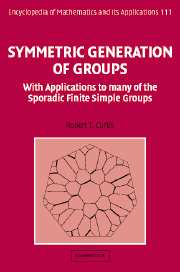Preface
Published online by Cambridge University Press: 21 March 2010
Summary
The book is aimed at postgraduate students and researchers into finite groups, although most of the material covered will be comprehensible to fourth year undergraduates who have taken two modules of group theory. It is based on the author's technique of symmetric generation, which seems able to present many difficult group-theoretic constructions in a more elementary manner. It is thus the aim of the book to make these beautiful, but combinatorially complicated, objects accessible to a wider audience.
The stimulus for the investigations which led to the contents of the book was a question from a colleague of mine, Tony Gardiner, who asked me if the Mathieu group M24 could contain two copies of the linear group L3(2) which intersect in a subgroup isomorphic to the symmetric group S4. He needed such a configuration in order to construct a graph with certain desirable properties. I assured him that the answer was almost certainly yes, but that I would work out the details. I decided to use copies of L3(2) which are maximal in M24 and found that the required intersection occurred in the nicest possible way, in that one could find subgroups H ≅ K ≅ L3(2), with H ∩ K ≅ S4, and an involution t such that CM24(H ∩ K) = 〈t〈 and Ht = K. This means that t has seven images under conjugation by H, and the maximality of H together with the simplicity of M24 mean that these seven involutions must generate M24. The symmetry of the whole set-up enables one to write down seven corresponding involutory permutations on 24 letters directly from a consideration of the action of L3(2) on 24 points.
- Type
- Chapter
- Information
- Symmetric Generation of GroupsWith Applications to many of the Sporadic Finite Simple Groups, pp. ix - xiiPublisher: Cambridge University PressPrint publication year: 2007

